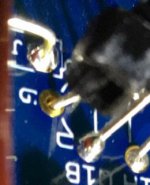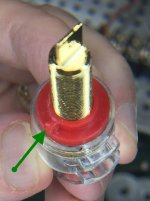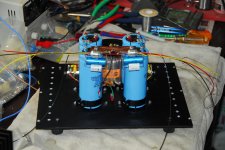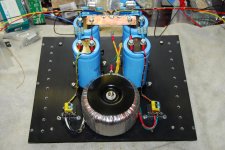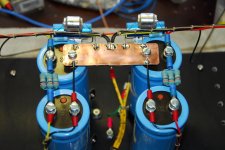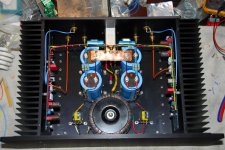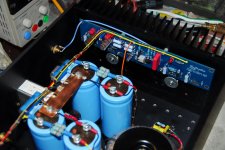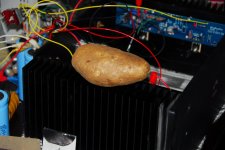well , your mileage may and must vary from mine .....
I spent considerable amount of time and energy to get rid even of any kind of resistive attenuator in signal chain, so that is my experience
if you don't hear difference, even better for you , especially for your wallet
Thing is, you have to get in your to wallet to find out whether resistance attenuation is, or is not, the optimum method.
I did, and it wound up being money very well spent. (happy ears emoji here)
PCB connections
I was just curious what peoples favorite ways to connect wire ends to PCB's are.
And why. Anything and everything is helpful. Fittings, wire prep, soldering techniques. There are a lot of wire sizes and PCB hole sizes.
Thanks,
Don
I was just curious what peoples favorite ways to connect wire ends to PCB's are.
And why. Anything and everything is helpful. Fittings, wire prep, soldering techniques. There are a lot of wire sizes and PCB hole sizes.
Thanks,
Don
spryor
On one photo it looks like a jfet gate is unsoldered, is it?
It should be - I soldered everything from the bottom, and the solder didn't always flow through to the top of the PCB. Thank you for noticing that. I'll double check.
Hi all, I had a question regarding the speaker binding posts that come in the diyaudio parts kit. There is a red plastic piece with a small tab, this tab fits into the back panel slot so that the post does not rotate (see picture). Ok great, but the tabs are in random places on my posts and wont move. How does one rotate them so that they are in the correct place so that the wire opening slot is pointing in same consistent direction? I have tried rotating but it doesn't budge and I don't want to break it. I'm sure I'm missing something.
Attachments
It should be - I soldered everything from the bottom, and the solder didn't always flow through to the top of the PCB. Thank you for noticing that. I'll double check.
I would double check everything. BA3 FE and Aleph J should be dead silent. I simply followed 6l6's build guides.
2 BA3 FE, 1 BA3 power amp and Aleph J just as he wrote and all three are quiet as the grave.
If not, something is off. Maybe very minor, but something. For best sleep, I don't like Band-Aids,
But that is just me. Maybe something in your environment is different?
Russellc
random places
I had same problem, try this.
That plastic part that is keyed into the back plate is actually keyed into the part also. Grab that little keying part with finger nails or needle nose pliers and pull it out. no force is required. then rotate it to the position you want and push it back into its place. Don't even have to take it off the post. Pretty clever.
r,
Don
Hi all, I had a question regarding the speaker binding posts that come in the diyaudio parts kit. There is a red plastic piece with a small tab, this tab fits into the back panel slot so that the post does not rotate (see picture). Ok great, but the tabs are in random places on my posts and wont move. How does one rotate them so that they are in the correct place so that the wire opening slot is pointing in same consistent direction? I have tried rotating but it doesn't budge and I don't want to break it. I'm sure I'm missing something.
I had same problem, try this.
That plastic part that is keyed into the back plate is actually keyed into the part also. Grab that little keying part with finger nails or needle nose pliers and pull it out. no force is required. then rotate it to the position you want and push it back into its place. Don't even have to take it off the post. Pretty clever.
r,
Don
Another Aleph J finished and running perfectly
I finally have just about finished the Aleph J. I just need to install the blue LED and find the top cover. All the proper parts have been installed, all the .47Rs as they should be, all wiring is Teflon coated silver plated including the input coax. All of it came from the Boeing surplus store over 25 years ago, what a treasure trove that was. I even laced the wiring, something I learned back in the early 80's at BCIT.
I am very happy with the static results so far. Heat sinks ~55C with idle at 1.9A. The LVB2560 bridge rec. stays at the same temp as the chassis, about 45C. ~75mV of ripple on the supply and ~3mV AC on the output with inputs open. AC draw from the wall 220W.
A few pictures of it going together...I will post a few more once I get all the test leads out of it. 😀 Can hardly wait to listen to it. 🙂
Cheers
I finally have just about finished the Aleph J. I just need to install the blue LED and find the top cover. All the proper parts have been installed, all the .47Rs as they should be, all wiring is Teflon coated silver plated including the input coax. All of it came from the Boeing surplus store over 25 years ago, what a treasure trove that was. I even laced the wiring, something I learned back in the early 80's at BCIT.
I am very happy with the static results so far. Heat sinks ~55C with idle at 1.9A. The LVB2560 bridge rec. stays at the same temp as the chassis, about 45C. ~75mV of ripple on the supply and ~3mV AC on the output with inputs open. AC draw from the wall 220W.
A few pictures of it going together...I will post a few more once I get all the test leads out of it. 😀 Can hardly wait to listen to it. 🙂
Cheers
Attachments
Last edited:
Thanks boys, appreciate the compliments.
It's all solid aluminum, the bottom and back are 1/4", front panel 3/8" thick, and all anodized. I made these many years ago when I was doing engineering/prototype work, these were leftover and the bottoms were never drilled, otherwise all the holes would have been black as well. I was sure happy to put one to good use for this awesome amp design. As I come from an electronics manufacturing background, I was given the opportunity to acquire surplus parts as they went EOL (End Of Life) and being a hoarder 😀, have amassed probably 5,000lbs of parts over the years, and as a result, needed to buy very little. All the hardware in this build is stainless, and as mentioned Teflon insulated wiring, nylon standoffs, and transformers that I had that just happened to fit perfectly for this, dual 20V @ 8A, cool.
Thanks Nelson, Jim and all those who have helped develop this and who have put so much effort in to help others to get them finished and working 100%.
Cheers
It's all solid aluminum, the bottom and back are 1/4", front panel 3/8" thick, and all anodized. I made these many years ago when I was doing engineering/prototype work, these were leftover and the bottoms were never drilled, otherwise all the holes would have been black as well. I was sure happy to put one to good use for this awesome amp design. As I come from an electronics manufacturing background, I was given the opportunity to acquire surplus parts as they went EOL (End Of Life) and being a hoarder 😀, have amassed probably 5,000lbs of parts over the years, and as a result, needed to buy very little. All the hardware in this build is stainless, and as mentioned Teflon insulated wiring, nylon standoffs, and transformers that I had that just happened to fit perfectly for this, dual 20V @ 8A, cool.
Thanks Nelson, Jim and all those who have helped develop this and who have put so much effort in to help others to get them finished and working 100%.
Cheers
Last edited:
So, any listening yet?
Russellc
It's on the agenda for tomorrow...I'm still fiddling with bias, 🙄. The bottom is sitting at 57C and the xfmr is 65C. Before I assembled the amp, the heatsinks sitting alone were able to dissipate the 1.9A no problem and xfmr was cold. Now with the bottom plate, it seems to be drawing the heat from the sinks so I may try insulating the bottom from the sinks with fiber washers, as a test. The bridge recs only dissipate about 4W each and shouldn't heat that much. I may have to re-visit the drill press to get some more air flow through the amp. 😱
Updates tomorrow.
Cheers
Attachments
Last edited:
bridge dissipating more than 1 watt can benefit with the use of a heatsink...
i will put insulation pads on the power traffo instead...heatsinking is all about surface area, so the bottom plate adding extra surface area can only be a good thing for me...
i will put insulation pads on the power traffo instead...heatsinking is all about surface area, so the bottom plate adding extra surface area can only be a good thing for me...
The DC rails & returns, and the speakers' hookup wire, is very thin. I'd go with at least triple the cross-section. Even better, you could extend the copper plate to cover all 4 capacitors' screws🙂
Aleph J is a very wide band amplifier, the combination of silver-plated wire and wideband amp could result in high frequencies being too revealing.
The transformer, if damped correctly (quasimodo snubber) , could dissipate a lot less heat... I properly damped my transformer, which reduced its heat dissipation dramatically (initially, I thought the transformer was running hot due to around 4 amps of a constant current draw...). Now, it runs only mildly warm.
The speakers return wire should go straight to that copper plate.
Aleph J is a very wide band amplifier, the combination of silver-plated wire and wideband amp could result in high frequencies being too revealing.
The transformer, if damped correctly (quasimodo snubber) , could dissipate a lot less heat... I properly damped my transformer, which reduced its heat dissipation dramatically (initially, I thought the transformer was running hot due to around 4 amps of a constant current draw...). Now, it runs only mildly warm.
The speakers return wire should go straight to that copper plate.
kilohertz, that's a lovely clean build 
The only change I would make is to remove the insulation from the crimp terminals and solder them for long term reliability.

The only change I would make is to remove the insulation from the crimp terminals and solder them for long term reliability.
I had same problem, try this.
That plastic part that is keyed into the back plate is actually keyed into the part also. Grab that little keying part with finger nails or needle nose pliers and pull it out. no force is required. then rotate it to the position you want and push it back into its place. Don't even have to take it off the post. Pretty clever.
r,
Don
Thanks Don! yes it was that simple!
Good job, kilohertz! But, to my mind, this amplifier must have speaker protection. Have you ever seen DC voltage on the amplifier's output and blowing speaker?
- Home
- Amplifiers
- Pass Labs
- Aleph J illustrated build guide
